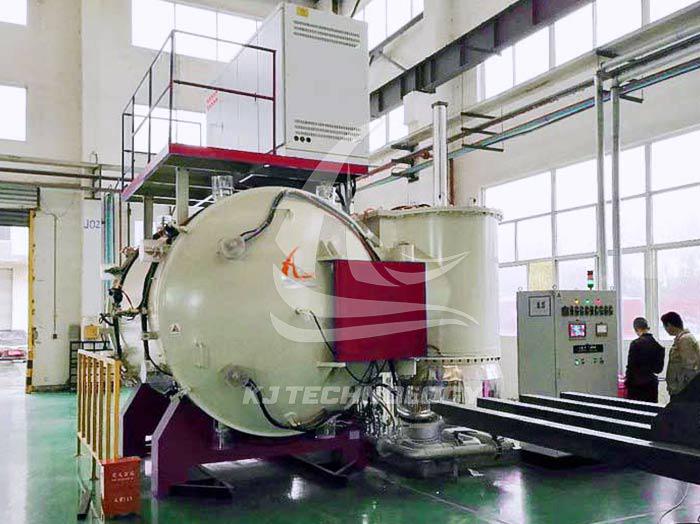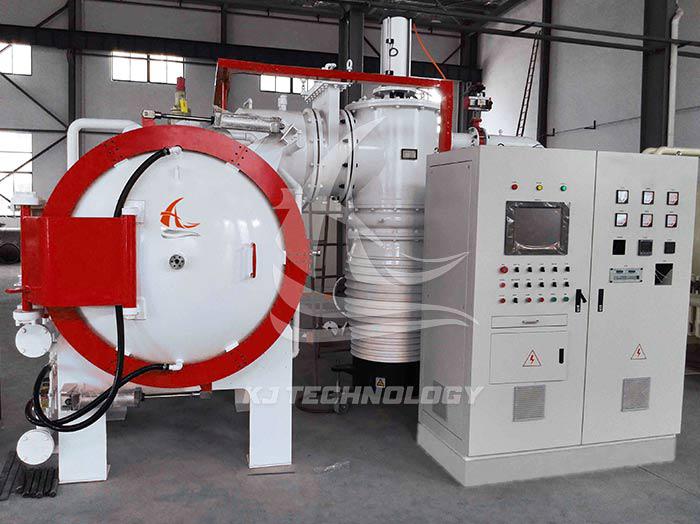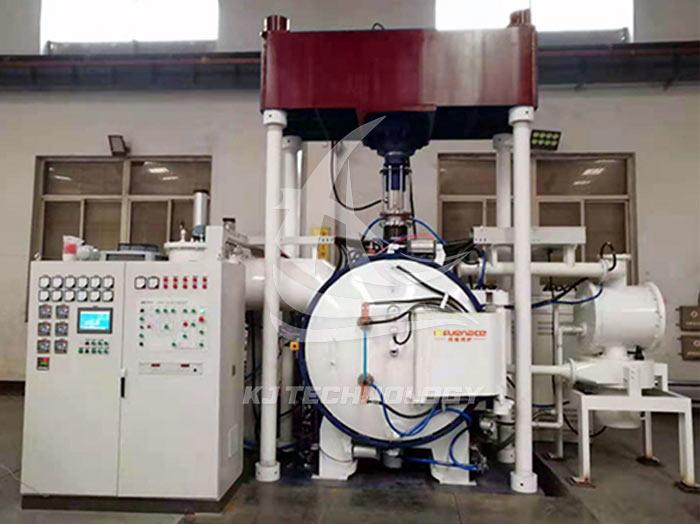Advantages of vertical high vacuum hot pressing electric furnace
 08-20-2025 Author: KJ technology
08-20-2025 Author: KJ technology
The vertical high vacuum hot pressing electric furnace combines three core technologies: vacuum environment, high-temperature heating, and mechanical pressurization, demonstrating significant advantages in the field of material processing. The following systematically summarizes its core advantages from four dimensions: technical performance, application effectiveness, economy, and environmental friendliness:
1. Technical performance advantages: precise control and efficient collaboration
Ultra high vacuum environment (10 ⁻⁵ Pa level)
Material protection: Thoroughly isolate active gases such as oxygen and nitrogen to prevent material oxidation, decarburization, or volatilization, especially suitable for high-purity ceramics, semiconductors, optical glass, and other materials that are sensitive to composition.
Reduce defects: The vacuum environment eliminates gas inclusions, reduces material porosity, and increases density (up to 99.5% or more).
Case: During the preparation of silicon nitride ceramic bearings, the vacuum hot pressing process increased the material's bending strength by 30% and extended its lifespan to twice that of traditional processes.
Accurate collaborative control of temperature and pressure
Temperature control: using PID algorithm+tungsten rhenium thermocouple, temperature fluctuation ≤ ± 1 ℃, supporting multi-stage programmed heating (such as rapid heating to 1200 ℃ and holding for 2 hours).
Pressure control: The hydraulic system achieves precise pressure adjustment (± 0.1MPa), supports one-way or two-way pressurization, and ensures uniform material stress.
Synergistic effect: High temperature puts the material in a thermoplastic state, pressure promotes particle rearrangement and pore elimination, significantly reduces sintering temperature (200-300 ℃ lower than atmospheric sintering), and shortens the process cycle.
Vertical structure optimization thermal efficiency
Heat concentration: The vertical layout of the furnace reduces heat loss, combined with water-cooled interlayers and high-efficiency insulation materials (such as alumina fibers), resulting in a 25% -35% increase in thermal efficiency compared to traditional horizontal furnaces.
Uniformity improvement: The vertical design combined with the airflow circulation system ensures a temperature field uniformity of ≤± 3 ℃ in the furnace, avoiding local overheating or underheating.
2. Application effect advantage: Significant improvement in material properties
Metal material processing
Refractory metal forming: solves the problem of cracking and deformation in traditional processes such as titanium alloys and nickel based alloys. For example, a certain enterprise used this equipment to prepare titanium alloy blades, achieving a density of 99.8% and increasing fatigue life by 40%.
Powder metallurgy: Rapid densification of metal powders through hot pressing, reducing subsequent machining and lowering costs.
Ceramic material processing
High performance ceramic sintering: After hot pressing, ceramic materials such as silicon nitride and silicon carbide can achieve a bending strength of 800-1200MPa and an increase in wear resistance of over 50%.
Preparation of transparent ceramics: Sintering alumina, magnesia alumina spinel, etc. in a vacuum environment to achieve high transmittance (>85%), used for laser windows, infrared detectors, etc.
Composite material processing
Metal based composite materials: Optimize the interface bonding of aluminum based silicon carbide, magnesium based boron nitride and other materials to achieve a balance between mechanical properties and thermal conductivity. For example, a battery manufacturer used this device to prepare aluminum based silicon carbide heat sinks with a thermal conductivity of 180W/(m · K), meeting the heat dissipation requirements of 5G devices.
Ceramic based composite materials: By strengthening the interface between carbon fibers and silicon carbide ceramics through hot pressing, the impact resistance of the material is improved.
Application in the field of new energy
Sintering of lithium battery electrodes: The hot pressing process reduces the internal resistance of the electrodes by 15%, and the cycle life exceeds 2000 times.
Annealing of photovoltaic silicon wafers: Annealing in a vacuum environment can reduce surface defects and improve photovoltaic conversion efficiency by 0.5% -1%.
3. Economic advantage: significant cost reduction and efficiency improvement
Shorten the process cycle
The rapid heating (minute level) and cooling (gas circulation cooling) functions shorten the production time of a single batch by 30% -50%. For example, a certain enterprise reduced its equipment turnover rate from the traditional 8-hour per batch to 5 hours per batch, resulting in a 60% increase in equipment turnover.
reduce energy consumption
Efficient insulation materials and vertical structures reduce heat loss, combined with induction heating or graphite carbon tube heating, reducing energy consumption by 20% -35% compared to traditional furnace types.
Improve yield rate
Precise control reduces the scrap rate, and a ceramic manufacturer has increased the finished product rate from 85% to 95% after use, saving over one million yuan in raw material costs annually.
Extend equipment lifespan
The vacuum environment reduces furnace oxidation, coupled with a water cooling system to protect heating elements, extending the service life of the equipment to 1.5-2 times that of traditional furnace types.
4. Environmental and safety advantages: meeting strict standards
Non polluting emissions
Vacuum environment closed operation, no waste gas or residue generated, fully compliant with environmental regulations such as RoHS and REACH.
Low noise design
The hydraulic system adopts a silent pump with a running noise of ≤ 65dB to improve the workshop environment.
Multiple security protections
Overpressure protection: Real time monitoring by pressure sensors, automatic pressure relief when exceeded.
Over temperature alarm: The dual circuit temperature control system prevents local overheating.
Vacuum interlock: Heating is prohibited when the vacuum degree is not reached to avoid material oxidation.
Remote monitoring: Supports PLC+human-machine interface, achieving 24-hour unmanned production and reducing the failure rate to below 0.5%.
Summarize
The vertical high vacuum hot pressing electric furnace has the core advantages of vacuum protection, precise collaborative control, high efficiency and energy saving, multi material adaptation, and automation safety. It not only significantly improves material performance (such as strength, density, transmittance, etc.), but also reduces production costs (energy consumption, scrap rate) and environmental risks. It is widely used in high-end manufacturing fields such as aerospace, electronic packaging, new energy, and semiconductors, and has become a key equipment for enterprises to achieve technological upgrades and product differentiation.








